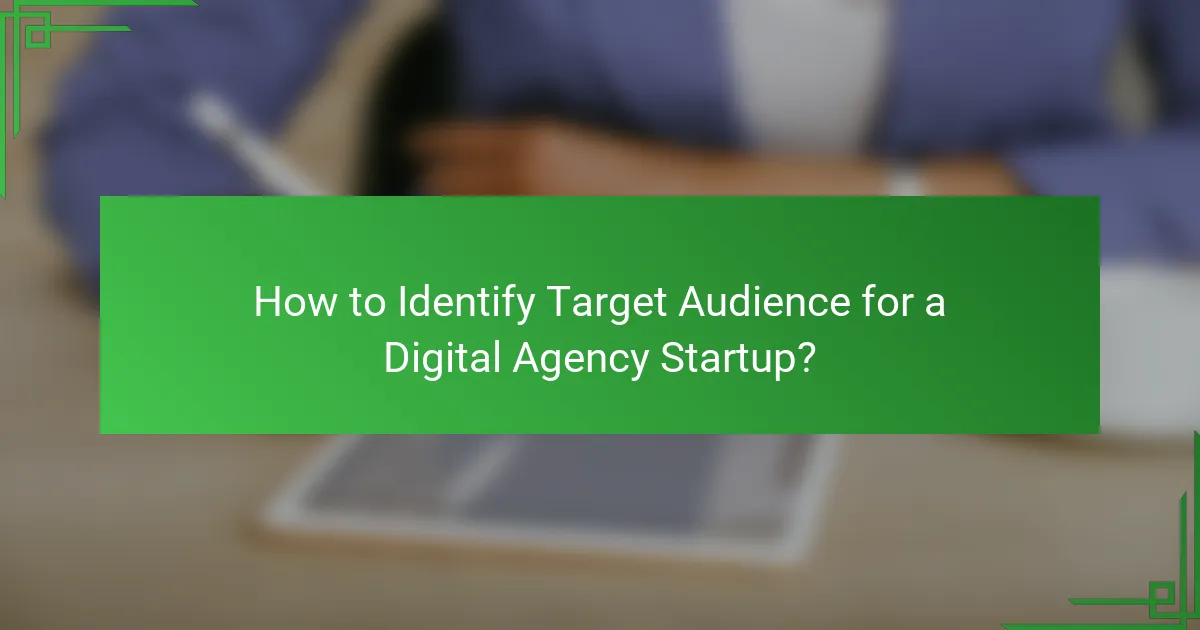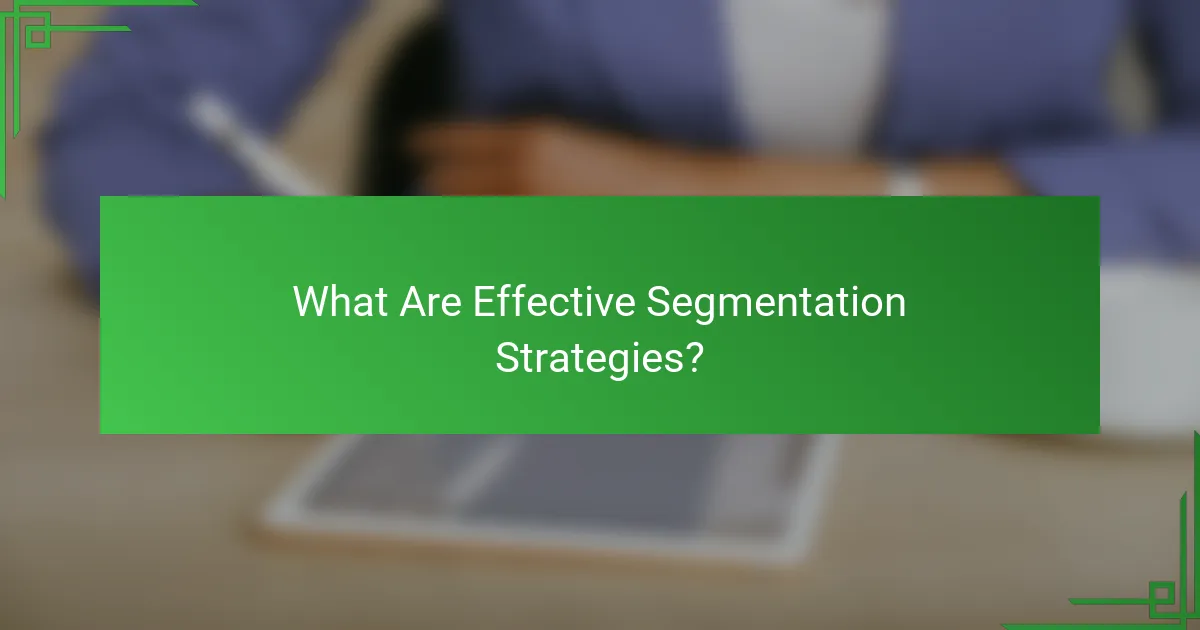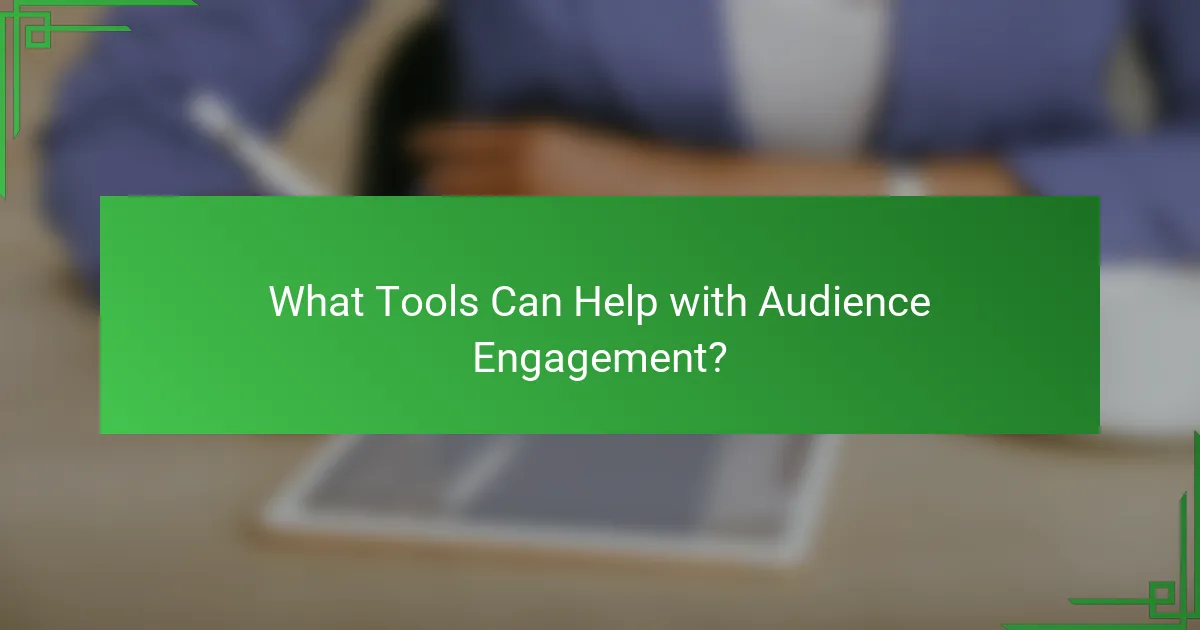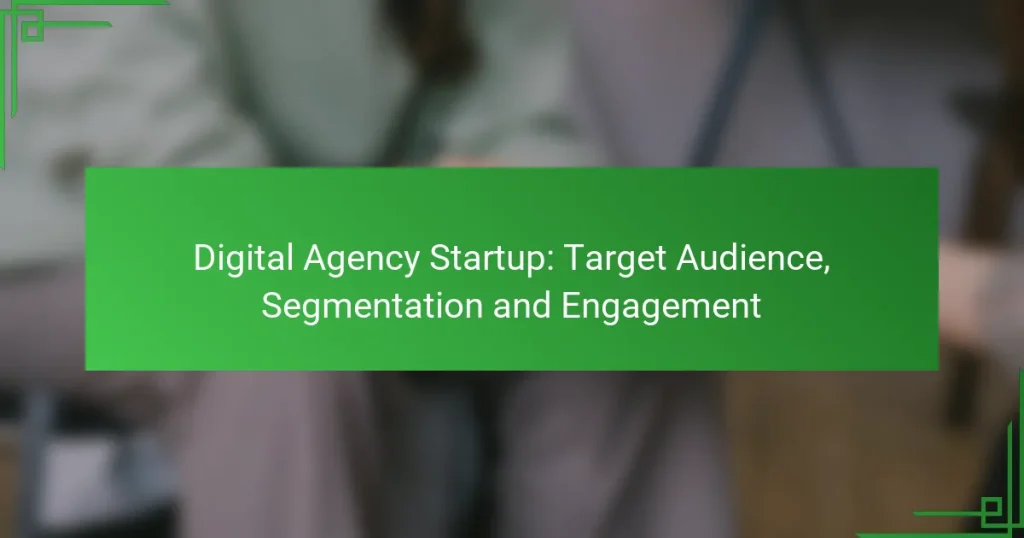For a digital agency startup, identifying your target audience is essential as it shapes your marketing strategies and service offerings. By segmenting your audience into distinct groups based on shared characteristics, you can tailor your messaging and engagement efforts to better meet their needs, ultimately enhancing brand loyalty and conversion rates.

How to Identify Target Audience for a Digital Agency Startup?
Identifying your target audience is crucial for a digital agency startup as it informs your marketing strategies and service offerings. By understanding who your ideal clients are, you can tailor your messaging and engagement efforts to meet their specific needs.
Demographic Analysis
Demographic analysis involves examining characteristics such as age, gender, income, education, and occupation of potential clients. For a digital agency, knowing the demographics helps in crafting targeted campaigns that resonate with specific groups.
For example, if your agency focuses on social media marketing for small businesses, you might target entrepreneurs aged 30-50 with a moderate income level. This information can guide your content creation and advertising placements.
Psychographic Profiling
Psychographic profiling delves into the attitudes, values, interests, and lifestyles of your target audience. Understanding these factors allows your agency to connect on a deeper emotional level with clients.
For instance, if your target audience values sustainability, you can emphasize eco-friendly practices in your marketing materials. This alignment can enhance brand loyalty and client engagement.
Behavioral Segmentation
Behavioral segmentation focuses on how potential clients interact with your services, including their purchasing behaviors and brand loyalty. Analyzing these patterns helps in predicting future actions and tailoring offerings accordingly.
For example, if you notice that a segment of your audience frequently engages with video content, you might prioritize video marketing services in your portfolio. This targeted approach can lead to higher conversion rates.
Geographic Considerations
Geographic considerations involve assessing the location of your target audience, which can influence their needs and preferences. Different regions may have varying market demands and cultural nuances.
For instance, a digital agency in Europe may need to adapt its strategies based on local languages and regulations, such as GDPR compliance. Understanding these geographic factors can enhance your agency’s relevance and effectiveness.
Market Research Tools
Utilizing market research tools is essential for gathering data about your target audience. Tools like surveys, social media analytics, and Google Analytics can provide valuable insights into audience behavior and preferences.
For example, using platforms like SurveyMonkey can help you gather direct feedback from potential clients, while Google Analytics can reveal which demographics are visiting your website. This data can inform your marketing strategies and service offerings effectively.

What Are Effective Segmentation Strategies?
Effective segmentation strategies involve dividing your target audience into distinct groups based on shared characteristics to tailor your marketing efforts. This approach enhances engagement and improves the overall effectiveness of your campaigns.
Segmenting by Industry
Segmenting by industry allows digital agencies to focus on specific sectors such as healthcare, finance, or retail. Each industry has unique challenges and requirements, enabling agencies to customize their services accordingly.
For example, a digital agency targeting the healthcare sector might emphasize compliance with regulations like HIPAA, while one focused on retail could highlight e-commerce solutions. Understanding industry-specific needs helps agencies create relevant content and offers.
Segmenting by Business Size
Segmenting by business size helps agencies tailor their services to the needs of small, medium, or large enterprises. Each size category often has different budgets, resources, and marketing goals, which influence their digital strategies.
Small businesses may prioritize cost-effective solutions, while larger companies might seek comprehensive digital transformations. Agencies should consider these factors when developing packages and pricing structures to meet diverse client needs.
Segmenting by Service Needs
Segmenting by service needs involves categorizing clients based on the specific digital services they require, such as SEO, social media management, or web development. This approach allows agencies to align their offerings with client expectations and project scopes.
For instance, a startup may need branding and website design, while an established company might focus on digital marketing and analytics. Clearly identifying these needs enables agencies to provide targeted solutions and improve client satisfaction.

How to Engage Your Target Audience?
Engaging your target audience involves understanding their needs and preferences, then delivering tailored content and interactions. Effective engagement strategies can significantly enhance brand loyalty and conversion rates.
Content Marketing Strategies
Content marketing focuses on creating valuable, relevant content to attract and engage your audience. Consider developing blog posts, infographics, and videos that address common pain points or interests of your target demographic.
Utilize SEO techniques to ensure your content ranks well in search engines, making it easier for potential customers to find you. Aim for consistency in posting, ideally at least once a week, to keep your audience engaged and informed.
Social Media Engagement
Social media platforms are essential for engaging with your audience in real-time. Choose platforms that align with your target demographic, such as Instagram for younger audiences or LinkedIn for professionals.
Regularly post interactive content like polls, questions, and live Q&A sessions to foster community engagement. Monitor comments and messages to respond promptly, as timely interactions can enhance customer relationships.
Email Marketing Campaigns
Email marketing remains a powerful tool for direct engagement. Build a segmented email list based on user behavior and preferences to ensure your messages are relevant and personalized.
Consider using automated campaigns for welcome messages, product recommendations, or re-engagement strategies. Aim for a frequency of 1-4 emails per month to maintain interest without overwhelming your audience.
Webinars and Workshops
Hosting webinars and workshops can effectively engage your audience by providing valuable insights and fostering direct interaction. Choose topics that resonate with your audience’s interests and challenges.
Promote these events through your website and social media channels, and consider offering incentives like free resources or discounts for attendees. Aim for a duration of 30-60 minutes to keep participants engaged without losing their attention.

What Tools Can Help with Audience Engagement?
Effective audience engagement relies on the right tools to connect with your target market. Utilizing platforms designed for customer relationship management, email marketing, and social media management can significantly enhance your outreach and interaction strategies.
HubSpot for CRM
HubSpot is a comprehensive customer relationship management (CRM) tool that helps businesses manage their interactions with current and potential customers. It offers features such as contact management, sales pipeline tracking, and performance analytics, making it easier to understand customer behavior and preferences.
When using HubSpot, consider integrating it with your existing tools for a seamless experience. Its free tier is suitable for startups, while paid plans offer advanced features like automation and reporting. Regularly updating your contact database can help maintain engagement and improve communication.
Mailchimp for Email Marketing
Mailchimp is a popular email marketing platform that allows businesses to create, send, and analyze email campaigns. Its user-friendly interface and customizable templates make it accessible for startups looking to engage their audience through newsletters and promotional emails.
To maximize effectiveness, segment your email list based on customer behavior or demographics. This targeted approach can lead to higher open and click-through rates. Additionally, monitor campaign performance through Mailchimp’s analytics to refine your strategy over time.
Hootsuite for Social Media Management
Hootsuite is a powerful social media management tool that enables businesses to schedule posts, track engagement, and analyze social media performance across multiple platforms. This can save time and ensure consistent messaging across channels.
When using Hootsuite, take advantage of its scheduling feature to plan posts during peak engagement times. Regularly review analytics to identify which content resonates most with your audience. Avoid over-scheduling; maintaining a balance between automated posts and real-time engagement is crucial for authentic interaction.

What Metrics to Measure Audience Engagement?
To effectively measure audience engagement, focus on metrics that reflect user interaction and interest. Key metrics include website traffic analytics, social media interaction rates, and email open and click rates, each providing insights into how well your content resonates with your target audience.
Website Traffic Analytics
Website traffic analytics track the number of visitors to your site and their behavior during their visit. Key metrics include page views, unique visitors, and average session duration. Tools like Google Analytics can help you monitor these metrics and identify trends over time.
Consider setting benchmarks for your website traffic based on industry standards. For instance, a healthy website might aim for a bounce rate below 40% and an average session duration of over two minutes. Regularly review these metrics to adjust your content strategy accordingly.
Social Media Interaction Rates
Social media interaction rates measure how users engage with your posts through likes, shares, comments, and overall reach. High interaction rates indicate that your content is resonating with your audience. Aim for a consistent engagement rate of around 1-5% depending on the platform.
To improve interaction rates, focus on creating shareable content and actively engaging with your audience. Utilize tools like Hootsuite or Buffer to analyze which types of posts perform best and adjust your strategy to emphasize those formats.
Email Open and Click Rates
Email open and click rates are critical for assessing the effectiveness of your email marketing campaigns. A typical open rate ranges from 15-25%, while click rates often fall between 1-5%. These metrics help you understand how well your subject lines and content are performing.
To enhance these rates, segment your email list based on user behavior and preferences. Personalization can significantly boost engagement; for example, using the recipient’s name in the subject line can improve open rates. Regularly test different subject lines and content formats to determine what resonates best with your audience.


